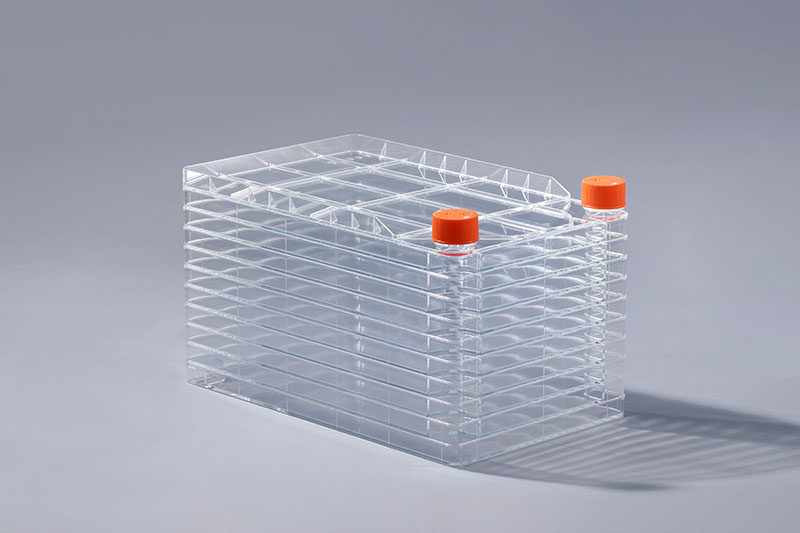The cell factory is a multi-layered cell culture vessel, which is made of polystyrene (PS) raw materials through an injection molding process, and is mainly used to culture adherent cells. The culture container has a novel structure, which can save space and at the same time reduce the quality control cost of the enterprise.
Common application fields of cell factories include vaccine production, monoclonal antibody and pharmaceutical industry, etc. The production process of products in these fields is complex, especially in the cell culture stage, which involves procedures such as liquid exchange-culturing, rehydration-culturing, etc. It is very easy to introduce into various This kind of pollution will lead to the reduction of production efficiency or even the stagnation of production, which will bring certain economic losses to the relevant enterprises.
FuDau 10 Layers Cell Factory
This multi-layered cell culture container has common specifications including 1-layer, 2-layer, 5-layer, 10-layer, 40-layer, etc. In the cell expansion stage, only the specifications of the product need to be changed, and it will not take up too much. space. It utilizes a large culture area in a limited space, saves a lot of workshop space, and reduces the quality control cost and downstream purification cost of the enterprise. On the other hand, this consumable is equipped with a complete set of piping systems such as sealing caps, breathable caps, small port conversion caps, CPC adapters, tee pipes, silicone tubes/hot melt tubes, ECS quick connectors, etc. The mutual cooperation of the lids realizes aseptic transfer of liquids, and multiple cell factories can be connected in series to form a closed pipeline to reduce the risk of cell contamination.
In general, the cell factory is a large-scale cell culture vessel with unique structural design and convenient use. It not only meets the industrial production in different fields, but also reduces the cost of quality control for enterprises.
The FAI climbed 5.9 percent year-on-year in the first 11 months of 2018, quickening from the 5.7-percent growth in Jan-Oct, the National Bureau of Statistics (NBS) said Friday in an online statement.
The key indicator of investment, dubbed a major growth driver, hit the bottom in August and has since started to rebound steadily.
In the face of emerging economic challenges home and abroad, China has stepped up efforts to stabilize investment, in particular rolling out measures to motivate private investors and channel funds into infrastructure.
Friday's data showed private investment, accounting for more than 60 percent of the total FAI, expanded by a brisk 8.7 percent.
NBS spokesperson Mao Shengyong said funds into weak economic links registered rapid increases as investment in environmental protection and agriculture jumped 42 percent and 12.5 percent respectively, much faster than the average.
In breakdown, investment in high-tech and equipment manufacturing remained vigorous with 16.1-percent and 11.6-percent increases respectively in the first 11 months. Infrastructure investment gained 3.7 percent, staying flat. Investment in property development rose 9.7 percent, also unchanged.
 English
English



















































